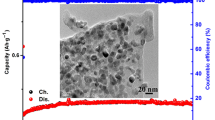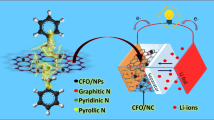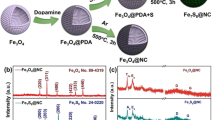Abstract
Cobalt phosphide (CoP) has been emerging as alternative lithium-ion batteries (LIBs) anode in view of the outstanding thermodynamic stability and high theoretical capacity. However, the lithium storage behaviors were impeded by poor cycling and rate performance induced by huge volumetric changes of CoP anodes during Li+ intercalation/deintercalation and the poor reaction kinetics caused by low electronic conductivity. Herein, the uniquely designed hemoglobin-like composites consisting of CoP nanoparticles coated by N, P-doped carbon shell (CoP@PNC) were prepared via a supramolecular self-assembly method, followed by the facile heat treatment process, which presented the amorphous phase. Based on the synergistic effects of rational nano/microstructure, double heterogeneous elements doped carbon substrate and amorphous phase, the transport paths of Li+ and e− were shortened, the electronic conductivity was enhanced, the volumetric changes were effectively alleviated, resulting in outstanding electrochemical performance when applied as anode electrodes. The CoP@PNC electrodes deliver a capacity of 806.8 mAh g−1 after 100 cycles at 0.1 A g−1 and 523.9 mAh g−1 after 3000 cycles at 2.0 A g−1. Furthermore, pseudo-capacitance behavior dominates the storage mechanism of CoP@PNC electrodes based on the quantitative kinetic analysis result that a high ratio of 66% in total capacity at 0.5 mV−1. This work illuminates the route to effectively relieve the huge volumetric changes to improve the electrochemical performance of transition metal phosphide and promote their practical application steps as electrodes for high energy density batteries.






Similar content being viewed by others
References
Yang J, Cui N, Han D, Shen J, Wu G, Zhang Z, Qin L, Zhou B, Du A (2022) A simple strategy for constructing hierarchical composite electrodes of PPy-posttreated 3D-printed carbon aerogel with ultrahigh areal capacitance over 8000 mF cm–2. Adv Mater Technol 7(7):2101325
Sayyed SG, Mahadik MA, Shaikh AV, Jang JS, Pathan HM (2019) Nano-metal oxide based supercapacitor via electrochemical deposition. ES Energy Environ 3:25–44
Yang J, Cui N, Lu J, Han D, Shen J, Zhang Z, Qin L, Zhou B, Du A (2022) A facile and versatile post-treatment method to efficiently functionalize 3D-printed carbon aerogels via introducing tailored metal elements. Acs Appl Energy Mater 5(10):11970–11976
Zhang Y, Ding P, Wu W, Hideo K, Shen Y, Wu D, **e X, Hou C, Sun X, Yang X, Du W (2023) Facile synthesis of reduced graphene oxide@Co3O4 composites derived from assisted liquid-phase plasma electrolysis for high-performance hybrid supercapacitors. Appl Surf Sci 609:155188
Ma Y, **e X, Yang W, Yu Z, Sun X, Zhang Y, Yang X, Kimura H, Hou C, Guo Z, Du W (2021) Recent advances in transition metal oxides with different dimensions as electrodes for high-performance supercapacitors. Adv Compos Hybrid Mater 4(4):906–924
Li Y, Liu Y, Qian Q, Wang G, Zhang G (2020) Supramolecular assisted one-pot synthesis of donut-shaped CoP@PNC hybrid nanostructures as multifunctional electrocatalysts for rechargeable Zn-air batteries and self-powered hydrogen production. Energy Storage Mater 28:27–36
Yang W, Peng D, Kimura H, Zhang X, Sun X, Pashameah RA, Alzahrani E, Wang B, Guo Z, Du W, Hou C (2022) Honeycomb-like nitrogen-doped porous carbon decorated with Co3O4 nanoparticles for superior electrochemical performance pseudo-capacitive lithium storage and supercapacitors. Adv Compos Hybrid Mater 5:3146–3157
Hou C, Yang W, Kimura H, **e X, Zhang X, Sun X, Yu Z, Yang X, Zhang Y, Wang B, Xu B, Sridhar D, Algadi H, Guo Z, Du W (2023) Boosted lithium storage performance by local build-in electric field derived by oxygen vacancies in 3D holey N-doped carbon structure decorated with molybdenum dioxide. J Mater Sci Technol 142:185–195
Dang C, Mu Q, **e X, Sun X, Yang X, Zhang Y, Maganti S, Huang M, Jiang Q, Seok I, Du W, Hou C (2022) Recent progress in cathode catalyst for nonaqueous lithium oxygen batteries: a review. Adv Compos Hybrid Mater 5:606–626
Yoon N, Young C, Kang D, Park H, Lee JK (2021) High-conversion reduction synthesis of porous silicon for advanced lithium battery anodes. Electrochim Acta 391:138967
Hou C, Tai Z, Zhao L, Zhai Y, Hou Y, Fan Y, Dang F, Wang J, Liu H (2018) High performance MnO@C microcages with a hierarchical structure and tunable carbon shell for efficient and durable lithium storage. J Mater Chem A 6(20):9723–9736
Liu Y, Wang X, Wan W, Li L, Dong Y, Zhao Z, Qiu J (2016) Multifunctional nitrogen-doped graphene nanoribbon aerogels for superior lithium storage and cell culture. Nanoscale 8(4):2159–2167
Sun R, Bai Y, Bai Z, Peng L, Luo M, Qu M, Gao Y, Wang Z, Sun W, Sun K (2022) Phosphorus vacancies as effective polysulfide promoter for high-energy-density lithium-sulfur batteries. Adv Energy Mater 12(12):2102739
Liu X, Yang W, Liu Z, Fan H, Zheng W (2020) In-situ synthesis of coral-like molybdenum phosphide (MoP) microspheres for lithium-ion battery. Acta Metall Sin 34(3):401–409
Zhao X, Luo D, Wang Y, Liu ZH (2019) Reduced graphene oxide-supported CoP nanocrystals confined in porous nitrogen-doped carbon nanowire for highly enhanced lithium/sodium storage and hydrogen evolution reaction. Adv Compos Hybrid Mater 12(11):2872–2880
Liu C, Li Y, Peng T, Luo S, Feng Y, **e W, Lu D, Sun W (2020) Construction of carbon confined CoP@carbon nanotube hybrid networks assisted by phytic acid toward high-performance lithium-ion batteries. J Power Sources 468:228393
Zong H, Hu L, Wang Z, Qi R, Yu K, Zhu Z (2021) Metal-organic frameworks-derived CoP anchored on MXene toward an efficient bifunctional electrode with enhanced lithium storage. Chem Eng J 416:129102
Yang Y, Jiang Y, Fu W, Liao XZ, He YS, Tang W, Alamgir FM, Ma ZF (2019) Cobalt phosphide embedded in a graphene nanosheet network as a high-performance anode for Li-ion batteries. Dalton 48(22):7778–7785
Li FF, Gao JF, He ZH, Kong LB (2020) Design and synthesis of CoP/r-GO hierarchical architecture: dominated pseudocapacitance, fasted kinetics features, and Li-ion capacitor applications. ACS Appl Energy Mater 3(6):5448–5461
Liang L, Li J, Zhu M, Li Y, Chou S, Li W (2021) Cobalt chalcogenides/cobalt phosphides/cobaltates with hierarchical nanostructures for anode materials of lithium-ion batteries: improving the lithiation environment. Small 17(9):1903418
Chen Z, Li H (2020) The improved anode performance enabled by Ni2P@C embedded in echinus-like porous carbon for lithium-ion battery. Nanotechnology 31(21):215405
Sun S, **e T, Tao S, Sheng P, Han Z, Qian B, Jiang X (2019) Formation of nitrogen-doped carbon-coated CoP nanoparticles embedded within graphene oxide for lithium-ion batteries anode. Energy Technol-Ger 8(3):1901089
Sun H, Wang J, Li W, Yuan F, Wang Q, Zhang D, Wang B, Wu YA (2021) Spanish-dagger shaped CoP blooms decorated N-doped carbon branch anode for high-performance lithium and sodium storage. Electrochim Acta 388:138628
Ge X, Li Z, Yin L (2021) Metal-organic frameworks derived porous core/shell CoP@C polyhedrons anchored on 3D reduced graphene oxide networks as anode for sodium-ion battery. Nano Energy 32:117–124
Lu H, Qian R, Yao T, Li C, Li L, Wang H (2021) Synthesis of spherical carbon-coated CoP nanoparticles for high-performance lithium-ion batteries. Energy Technol 9(10):2100605
Yang J, Zhang Y, Sun C, Liu H, Li L, Si W, Huang W, Yan Q, Dong X (2016) Graphene and cobalt phosphide nanowire composite as an anode material for high performance lithium-ion batteries. Nano Res 9(3):612–621
Wang X, Na Z, Yin D, Wang C, Wu Y, Huang G, Wang L (2018) Phytic acid-assisted formation of hierarchical porous CoP/C nanoboxes for enhanced lithium storage and hydrogen generation. ACS Nano 12(12):12238–12246
Zhai Y, Zhou S, Guo L, **n X, Zeng S, Qu K, Wang N, Zhang X (2022) Zeolitic imidazolate framework 67-derived Ce-doped CoP@N-doped carbon hollow polyhedron as high-performance anodes for lithium-ion batteries. Crystals 12(4):533
Wang J, Han W (2022) A review of heteroatom doped materials for advanced lithium-sulfur batteries. Adv Funct Mater 32(2):2107166
Li H, Zhu Y, Zhao K, Fu Q, Wang K, Wang Y, Wang N, Lv X, Jiang H, Chen L (2020) Surface modification of coordination polymers to enable the construction of CoP/N, P-codoped carbon nanowires towards high-performance lithium storage. J Colloid Interf Sci 565:503–512
Ma Q, Wang W, Zeng P, Fang Z (2017) Amorphous Ge/C composite sponges: synthesis and application in a high-rate anode for lithium-ion batteries. Langmuir 33(9):2141–2147
Zhang M, **ao X, Mao J, Lan Z, Huang X, Lu Y, Luo B, Liu M, Chen M, Chen L (2019) Synergistic catalysis in monodispersed transition metal oxide nanoparticles anchored on amorphous carbon for excellent low-temperature dehydrogenation of magnesium hydride. Mater Today Energy 12:146–154
Chen K, Huang X, Wan C, Liu H (2015) Efficient oxygen reduction catalysts formed of cobalt phosphide nanoparticle decorated heteroatom-doped mesoporous carbon nanotubes. Chem Commun 51(37):7891–7894
Chen X, Yu B, Dong Y, Zhu X, Zhang W, Ramakrishna S, Liu Z (2022) Electrospun porous carbon nanofibers decorated with iron-doped cobalt phosphide nanoparticles for hydrogen evolution. J Alloy Compd 918:165733
Zhang X, Han Y, Huang L, Dong S (2016) 3D graphene aerogels decorated with cobalt phosphide nanoparticles as electrocatalysts for the hydrogen evolution rreaction. Chemsuschem 9(21):3049–3053
Li L, Seng KH, Feng C, Liu HK, Guo Z (2013) Synthesis of hollow GeO2 nanostructures, transformation into Ge@C, and lithium storage properties. J Mater Chem A 1:7666–7672
Wang Y, Wang G (2013) Facile synthesis of Ge@C core-shell nanocomposites for high-performance lithium storage in lithium-ion batteries. Chem-Asian J 8(12):3142–3146
Zhao L, Dvorak DJ, Obrovac MN (2016) Layered amorphous silicon as negative electrodes in lithium-ion batteries. J Power Sources 332:290–298
Ferrari AC, Meyer JC, Scardaci V, Casiraghi C, Lazzeri M, Mauri F, Piscanec S, Jiang D, Novoselov KS, Roth S, Geim AK (2006) Raman spectrum of graphene and graphene layers. Phys Rev Lett 97(18):187401
Vereshchagin OS, Pankin DV, Smirnov MB, Vlasenko NS, Shilovskikh VV, Britvin SN (2021) Raman spectroscopy: a promising tool for the characterization of transition metal phosphides. Adv Compos Hybrid Mater 853:156468
Li H, Xu SM, Yan H, Yang L, Xu S (2018) Cobalt phosphide composite encapsulated within N, P-doped carbon nanotubes for synergistic oxygen evolution. Small 14(19):1800367
Chen J, Mao Z, Zhang L, Wang D, Xu R, Bie L, Fahlman BD (2017) Nitrogen-deficient graphitic carbon nitride with enhanced performance for lithium-ion battery anodes. ACS Nano 11(12):12650–12657
Hou C, Hou Y, Fan Y, Zhai Y, Wang Y, Sun Z, Fan R, Dang F, Wang J (2018) Oxygen vacancy derived local build-in electric field in mesoporous hollow Co3O4 microspheres promotes high-performance Li-ion batteries. J Mater Chem A 6(16):6967–6976
Hou C, Wang J, Du W, Wang J, Du Y, Liu C, Zhang J, Hou H, Dang F, Zhao L, Guo Z (2019) One-pot synthesized molybdenum dioxide-molybdenum carbide heterostructures coupled with 3D holey carbon nanosheets for highly efficient and ultrastable cycling lithium-ion storage. J Mater Chem A 7(22):13460–13472
Wu Z, Lei W, Wang J, Liu R, **a K, Xuan C, Wang D (2017) Various structured molybdenum-based nanomaterials as advanced anode materials for lithium-ion batteries. ACS Appl Mater Interfaces 9(14):12366–12372
**ong F, Tao H, Yue Y (2020) Role of amorphous phases in enhancing performances of electrode materials for alkali ion batteries. Front Mater 6:328
Han Z, Wang B, Liu X, Wang G, Wang H, Bai J (2018) Peapod-like one-dimensional (1D) CoP hollow nanorods embedded into graphene networks as an anode material for lithium-ion batteries. J Energy Chem 53(11):8445–8459
Shang F, Yu W, Shi R, Wan S, Zhang H, Wang B, Cao R (2021) Enhanced lithium storage performance guided by intricate-cavity hollow cobalt phosphide. Appl Surf Sci 563:150395
Liu Y, Que X, Wu X, Yuan Q, Wang H, Wu J, Gui Y, Gan W (2020) ZIF-67 derived carbon wrapped discontinuous CoxP nanotube as anode material in high-performance Li-ion battery. Mater Today Chem 17:100284
Luo Y, Fan Y, Wang S, Chen Q, Ali A, Zhu J, Kang Shen P (2022) Cobalt phosphide embedded in a 3D carbon frame as a sulfur carrier for high-performance lithium-sulfur batteries. J Electroanal Chem 912:116202
Gao H, Yang H, Zheng Y, Zhang Q, Hao J, Zhang S, Zheng H, Chen J, Liu H, Guo Z (2019) Three-dimensional porous cobalt phosphide nanocubes encapsulated in a graphene aerogel as an advanced anode with high coulombic efficiency for high-energy lithium-ion batteries. ACS Appl Mater Interfaces 11:5373–5379
Jiang J, Zhua K, Fang Y, Wang H, Ye K, Yan J, Wang G, Cheng K, Zhou L, Cao D (2018) Coralloidal carbon-encapsulated CoP nanoparticles generated on biomass carbon as a high-rate and stable electrode material for lithium-ion batterie. J Colloid Interf Sci 530:579–585
Augustyn V, Come J, Lowe MA, Kim JW, Taberna PL, Tolbert SH, Abruna HD, Simon P, Dunn B (2013) High-rate electrochemical energy storage through Li+ intercalation pseudocapacitance. Nat Mater 12(6):518–522
Li T, Zhang Q (2018) Advanced metal sulfide anode for potassium ion batteries. J Energy Chem 27(2):373–374
Funding
This work was supported by the National Natural Science Foundation of China (52207249), the research program of the top talent project of Yantai University (1115/2220001), the Yantai basic research project (2022JCYJ04), and the science fund of the Shandong Laboratory of Advanced Materials and Green Manufacturing (AMGM2021F11).
Author information
Authors and Affiliations
Contributions
Per the journal requirement of more than ten contributors, the required contribution can be briefly stated as Qin Mu, Huiyu Jiang, Hideo Kimura, Ruilin Liu, and **cheng Li make the samples and property characterizations; **aoyu Zhang, Zhipeng Yu, Xueqin Sun, and Chuanxin Hou inputted the electrochemical analysis and characterization; Chuanxin Hou, Hassan Algadi, Zhanhu Guo, and Wei Du* made the detailed experimental design and organize the paper. All authors have read the paper, modified the final version, and agreed on the submission.
Corresponding authors
Ethics declarations
Conflict of interest
The authors declare no competing interests.
Additional information
Publisher's Note
Springer Nature remains neutral with regard to jurisdictional claims in published maps and institutional affiliations.
Supplementary Information
Below is the link to the electronic supplementary material.
Rights and permissions
Springer Nature or its licensor (e.g. a society or other partner) holds exclusive rights to this article under a publishing agreement with the author(s) or other rightsholder(s); author self-archiving of the accepted manuscript version of this article is solely governed by the terms of such publishing agreement and applicable law.
About this article
Cite this article
Mu, Q., Liu, R., Kimura, H. et al. Supramolecular self-assembly synthesis of hemoglobin-like amorphous CoP@N, P-doped carbon composites enable ultralong stable cycling under high-current density for lithium-ion battery anodes. Adv Compos Hybrid Mater 6, 23 (2023). https://doi.org/10.1007/s42114-022-00607-y
Received:
Revised:
Accepted:
Published:
DOI: https://doi.org/10.1007/s42114-022-00607-y




